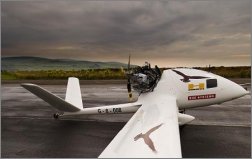Demonstrator success pushes effort to expand project and seek export buyers
 © BAE Systems |
| The Herti-1A has a 12.6m (41 ft) wingspan and an endurance of around 30h |
The propeller-driven UAV is to undergo a substantial increase to its flight-test campaign this year, with two BMW-engined prototypes to be joined by a further eight company-funded air vehicles powered by Rotax engines. BAE late last year provided first details of the 450kg (990lb) UAV, which conducted its first fully autonomous mission last August. Test objectives for this year include managing up to four air vehicles simultaneously using one ground control station and possibly flying with a Selex-supplied lightweight synthetic-aperture radar payload.
The Herti-1A success marked the culmination of a three-year effort that also included sorties of a remotely-piloted Kestrel blended wing-body demonstrator, two unmanned combat air vehicle-like Raven airframes, a derivative Corax reconnaissance platform and a jet-powered Herti-1D. “We have been doing a fair amount of experimentation work for some time and have got some very viable platforms out of that,” says Andy Wilson, sales and marketing director for the Military Autonomous Systems (Air) unit. “In the past three years we have picked out some of the absolutely core technologies.”
BAE is promoting Herti for military and civilian tasks including reconnaissance, surveillance, border patrol, pipeline monitoring and disaster management – targeting a potentially massive sector of the UAV market currently “not dominated by any brand, country or product,” says Wilson.
The Herti-1A has a 12.6m (41ft) wingspan and a projected endurance of around 30h. The company is also marketing an Imagery Collection and Exploitation payload, which Wilson says can pass compressed electro-optic images via a low-bandwidth datalink “not unlike your mobile phone line”.
CRAIG HOYLE / LONDON
Flight International's defence editor Craig Hoyle takes an in-depth look at BAE Systems' UAV plans in the 28 February-6 March edition, out today
Source: Flight International























